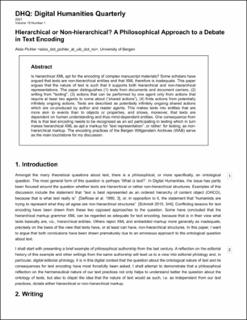Hierarchical or Non-hierarchical? A Philosophical Approach to a Debate in Text Encoding
Journal article, Peer reviewed
Published version

Åpne
Permanent lenke
https://hdl.handle.net/11250/2985599Utgivelsesdato
2021Metadata
Vis full innførselSamlinger
- Department of Philosophy [240]
- Registrations from Cristin [9791]
Originalversjon
Digital Humanities Quarterly. 2021, 15(1)Sammendrag
Is hierarchical XML apt for the encoding of complex manuscript materials? Some scholars have argued that texts are non-hierarchical entities and that XML therefore is inadequate. This paper argues that the nature of text is such that it supports both hierarchical and non-hierarchical representations. The paper distinguishes (1) texts from documents and document carriers, (2) writing from "texting", (3) actions that can be performed by one agent only from actions that require at least two agents to come about (“shared actions”), (4) finite actions from potentially infinitely ongoing shared actions. Texts are described as potentially infinitely ongoing shared actions which are co-produced by author and reader agents. This makes texts into entities that are more akin to events than to objects or properties, and shows, moreover, that texts are dependent on human understanding and thus mind-dependent entities. One consequence from this is that text encoding needs to be recognized as an act participating in texting which in turn makes hierarchical XML as apt a markup for “text representation”, or rather: for texting, as non-hierarchical markup. The encoding practices of the Bergen Wittgenstein Archives (WAB) serve as the main touchstone for my discussion.
